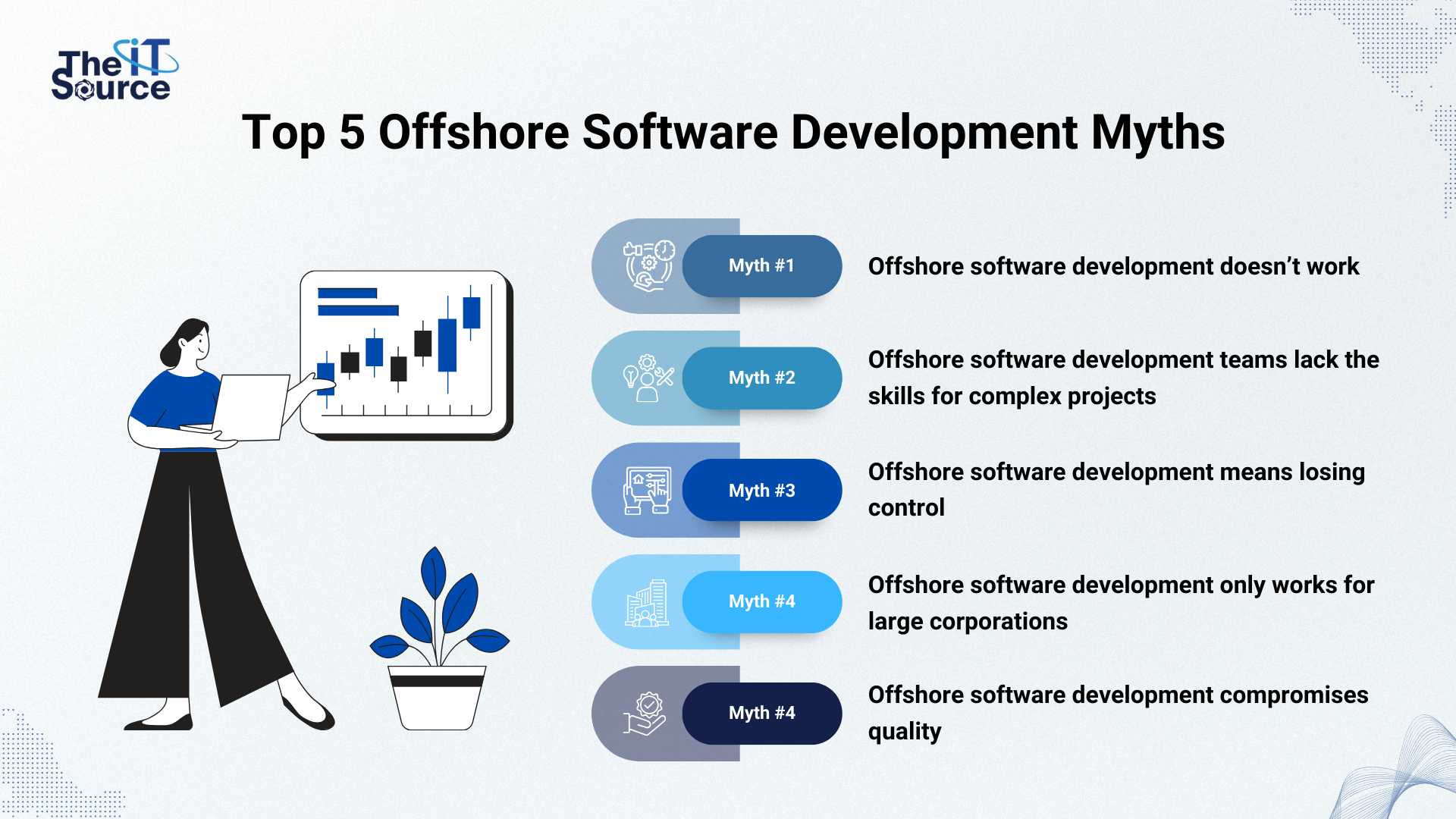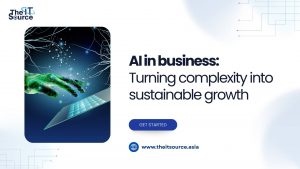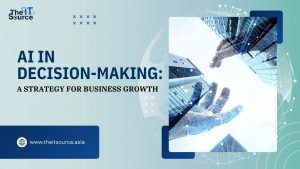5 Offshore software development myths costing growth in 2025

Did you know the global offshore software development market is expected to grow from $156 billion in 2024 to $179 billion in 2025, achieving a remarkable CAGR of nearly 15%? This growth isn’t just a statistic. It reflects a worldwide shift toward faster delivery, cost efficiency, and specialized talent that extends far beyond local hiring limits.
Yet, despite this momentum, offshore software development remains one of the most misunderstood strategies in the tech industry. Many decision-makers still rely on outdated cautionary tales – stories that no longer match the capabilities of today’s offshore development centers. These misconceptions can lead to missed market opportunities, rising operational costs, and slower innovation cycles.
The truth is, with the right partner and proven delivery frameworks, an offshore development center can transform those perceived risks into measurable business gains. In this article, we’ll debunk the most common myths, replace them with facts, and show how companies in Japan, Europe, and beyond are building safe, scalable, and future-ready solutions. You can also explore our full offshore development guide for Japan and Europe 2025 for deeper market insights and practical strategies.

Myth #1: Offshore software development doesn’t work
Some business leaders believe offshore software development is doomed to fail because of cultural differences, time zone gaps, or the lack of face-to-face interaction. These concerns are often fueled by outdated case studies or one-off failed projects that don’t reflect how modern offshore teams operate.
Fact: In 2025, leading offshore development centers have built robust processes to bridge every potential gap. From bilingual project managers and real-time communication tools to agile workflows that overlap with your core business hours, the offshore model is now designed for collaboration, not compromise.
For example, The IT Source works with Japanese and European enterprises to establish tailored engagement models that ensure 3–5 hours of direct overlap for daily stand-ups, sprint reviews, and issue resolution. Tools like Jira, Confluence, and Slack, combined with transparent reporting, keep all stakeholders aligned, no matter the geography.
External research also supports this shift. According to Gartner’s global outsourcing trends report, companies that adopted structured offshore engagement models saw a 35% faster project turnaround compared to purely in-house teams. This isn’t just about cutting costs; it’s about accelerating delivery while maintaining high quality.
To see how offshore can fit into your business without disrupting operations, explore our Offshore Development Services page for real-world use cases and proven engagement models.
Myth #2: Offshore software development teams lack the skills for complex projects
One of the most persistent offshore development myths is that overseas teams cannot match the technical depth or quality standards of local hires. This belief often comes from past experiences with poorly vetted vendors or outsourcing firms that prioritized headcount over capability.
Fact: Modern offshore software development centers follow rigorous hiring, training, and quality control frameworks that are on par with, and in many cases superior to, in-house recruitment. The best partners invest heavily in screening technical skills, assessing cultural alignment, and validating domain expertise before assigning any engineer to a client project.
At The IT Source, every developer in our offshore development center goes through a multi-stage evaluation process. This includes technical coding tests, peer reviews, and soft skill assessments to ensure they can work seamlessly with Japanese and European teams. Clients also participate in the selection process, conducting interviews to confirm the right fit.
Research from The Business Research Company in 2025 shows that more than 70 percent of enterprises using offshore development report equal or higher quality output compared to local teams. The advantage is even more significant for projects that require niche skills such as AI automation, blockchain, or advanced data analytics.
Working with a reputable partner allows companies to close the talent gap and access highly specialized engineers who can deliver secure, scalable, and industry-compliant solutions from the very beginning.
Myth #3: Offshore software development means losing control
When companies first consider offshore software development, one of the first fears that surfaces is loss of control. Leaders often imagine an external team halfway across the world making key decisions without their input, delivering code that fails to align with business goals, and leaving them scrambling to fix misaligned work.
This perception usually comes from confusing offshoring with traditional outsourcing. In a full outsourcing model, you hand over the entire project to a vendor who manages every aspect internally. Offshore development, when done right, works differently. It is about extending your capabilities, not replacing them.
Within TIS’s offshore model, every offshore development center operates as a direct extension of your team. You still set priorities, approve designs, and monitor progress. Our engineers work within your toolset and follow your development methodology, whether it’s Agile, Scrum, or Kanban. We remove the overhead of recruitment, HR, and infrastructure so you can focus on strategic delivery.
According to Deloitte’s 2024 Global Outsourcing Survey, many organizations now use a combination of onshore, nearshore, and offshore resources to maximize flexibility while maintaining control over critical projects. While the survey does not disclose a specific percentage on control, the clear shift toward hybrid models reflects a strong intent to retain governance while accessing global talent.
Myth #4: Offshore software development only works for large corporations
Many small and medium-sized enterprises (SMEs) hesitate to explore offshore software development because they think it is only viable for large enterprises with deep pockets and complex projects. This belief comes from outdated perceptions that offshore setups require massive investment, high coordination costs, or large engagement minimums.
That perception is no longer accurate. Today’s offshore development model is highly flexible. Businesses can start small with a focused team for targeted tasks and scale up when needed, matching their pace, budget, and strategy. This adaptability makes it accessible and effective for startups, mid-sized businesses, and enterprises alike.
Recent outsourcing statistics show that 37% of small businesses now outsource at least one business process, with IT and software development among the most common. This demonstrates that offshore development is already a trusted growth lever for lean organizations.
At TIS, we tailor offshore solutions to fit your business structure. Whether you need a small agile squad for an MVP or a larger team for multi-phase deployments, our engagement models, such as Time & Materials or Fixed Price, allow you to maintain control over costs while scaling responsibly. Our expertise in AI, automation, and domain-specific solutions further reduces barriers for SMEs looking to leverage global tech capabilities.
Takeaway: Offshore development is not reserved for tech giants. SMEs and startups can benefit just as much, if not more, by tapping into high-caliber global talent and flexible delivery models. With the right partner, your business can accelerate innovation without straining budgets or internal resources.
Myth #5: Offshore software development compromises quality
A common hesitation among decision-makers is the fear that offshore development will lead to subpar code, poorly tested features, or solutions that fail to meet industry standards. This belief often stems from early offshore experiments in the 2000s, when inconsistent processes and communication barriers sometimes affected outcomes.
The reality today is very different. Modern offshore development centers operate with internationally recognized standards and certifications. Quality is maintained through rigorous testing frameworks, transparent project tracking, and skilled engineers who are often certified in multiple technologies. Many offshore teams now have expertise in niche domains, enabling them to deliver highly specialized solutions that match or exceed in-house standards.
According to the Everest Group’s 2025 report on global delivery models, enterprises that work with mature offshore partners report over 85% satisfaction rates in quality, citing stronger adherence to coding standards and faster defect resolution compared to previous in-house benchmarks.
At TIS, quality assurance is built into every stage of development. From code reviews and continuous integration to automated testing pipelines, we ensure that deliverables are not only functional but also secure, scalable, and compliant with relevant regulations. For Japanese clients, this includes strict adherence to industry-specific guidelines, while European clients benefit from compliance with GDPR and the EU AI Act.
Takeaway: Quality is no longer a trade-off in offshore development. With the right partner and governance framework, you can achieve world-class results while benefiting from global cost and talent advantages.
Conclusion
The offshore development landscape in 2025 is no longer defined solely by lower costs. It is about building strategic, long-term partnerships that combine global talent, advanced technology, and regulatory expertise to deliver faster, safer, and more innovative solutions. Japanese and European enterprises that embrace this shift are already seeing measurable gains in agility, scalability, and market responsiveness.
The next competitive edge will belong to companies that move beyond outdated myths and instead focus on building trust, transparency, and technical excellence into their offshore strategies. Whether it’s AI-driven automation, secure compliance frameworks, or rapid scaling, the right partner can make offshore development a core engine of business growth.
If your organization is ready to explore how offshore software development can strengthen your innovation pipeline and market presence, start with a conversation. Contact The IT Source to see how we help clients turn strategy into results.


 日本語
日本語
